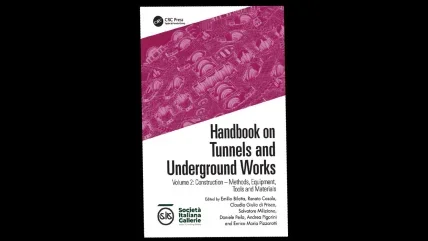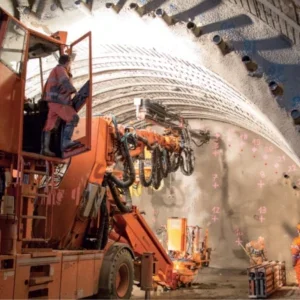
A second substantial book in the growing set of volumes of tunnelling industry knowledge from Italy has been published – Handbook on Tunnel and Underground Works, Volume 2: Construction – Methods, Equipment, Tools and Materials.
The set of handbooks comes from the Italian Tunnelling Society (Societa Italiana Gallerie – SIG), under the guidance of the same set of editors*. The first volume focused on design principles, the third volume will cover case histories and best practices. Publication began in 2022, and draws upon SIG’s successful focus on gathering industry information when Naples, Italy, hosted the World Tunnel Congress in 2019.
In the second volume, the focus is squarely on construction and its various aspects in the hardback book which is 575 pages, cover to cover. The subject is addressed in only seven chapters that, following the first introductory chapter, are major blocks of technical briefing information – especially the second chapter, clocking in at more than 200 pages. The very large chapter is able to work at such length, as are the others, with the aid of a sub-chapter structure – eight in the case of Chapter 2. Each chapter has its own set of editors.
An excellent textbook, with both depth and scope is the result. It feels much more than the name suggests, handbook. But in regard to the latter, that does work as it is well written and its explanations are clear, its many sections well-illustrated with black & white versions of graphics, tables and photos. As such, even with its size, and being sparing on equations, the second volume is easy to reach for, pick up and become immersed in, reading about this technique or that, from one methodology and use case to another.
Chapter 2 looks at a number of Construction Methods in tunnelling, through a sub-structure that covers drill and blast method, roadheaders, tunnel boring machines (TBMs), mechanised shaft sinking, and also deep foundations (slurry and diaphragm walls, and piling).
Chapter 3 is focused on Support Technology – covering shotcrete, anchors, ribs, cast insitu concrete & formwork, waterproofing, and segmental lining, and more.
Following, in Chapter 4, the handbook considers Auxiliary Methods Technology – looking at ground reinforcing and improving, and pre-support methods.
Chapter 5 looks at Monitoring, discussing the evolution in geotechnical instrumentation as a consequence of advances in microelectronics, telecoms and computing power. Technologies are discussed as well as fundamentals of measurement, such as strain, force, stress, water pressure and flow rates, temperature, and more. Also discussed is TBM systems monitoring, including consumptions, ground treatment quantification, and activity data (shift, production, utilisation, etc) for construction management.
While not the longest chapter, Chapter 6 puts a spotlight on Plant and Job Site Organisation. A very interesting chapter, it tends to this brief by looking at: material and mucking handling (trucks, locos, multiservice vehicles (MSVs), and conveyors); excavators, loaders. And special hauling equipment; sliding and lifting platforms; concreting support plant and formwork; TBM segmental tunnel precasting; and, construction-phase ventilation systems.;
Again not a long chapter, the last – Chapter 7 – covers an area not frequently addressed: Tunnel Refurbishment. It does so by looking at investigating existing tunnel lining; considering interventions to varying depths (shallow, deep, or rebuild) of the lining; and, working when traffic is present.
An excellent handbook, successfully assembling a highly effective and readable overview of the many and varied potential aspects of construction phase activities on tunnel projects.






